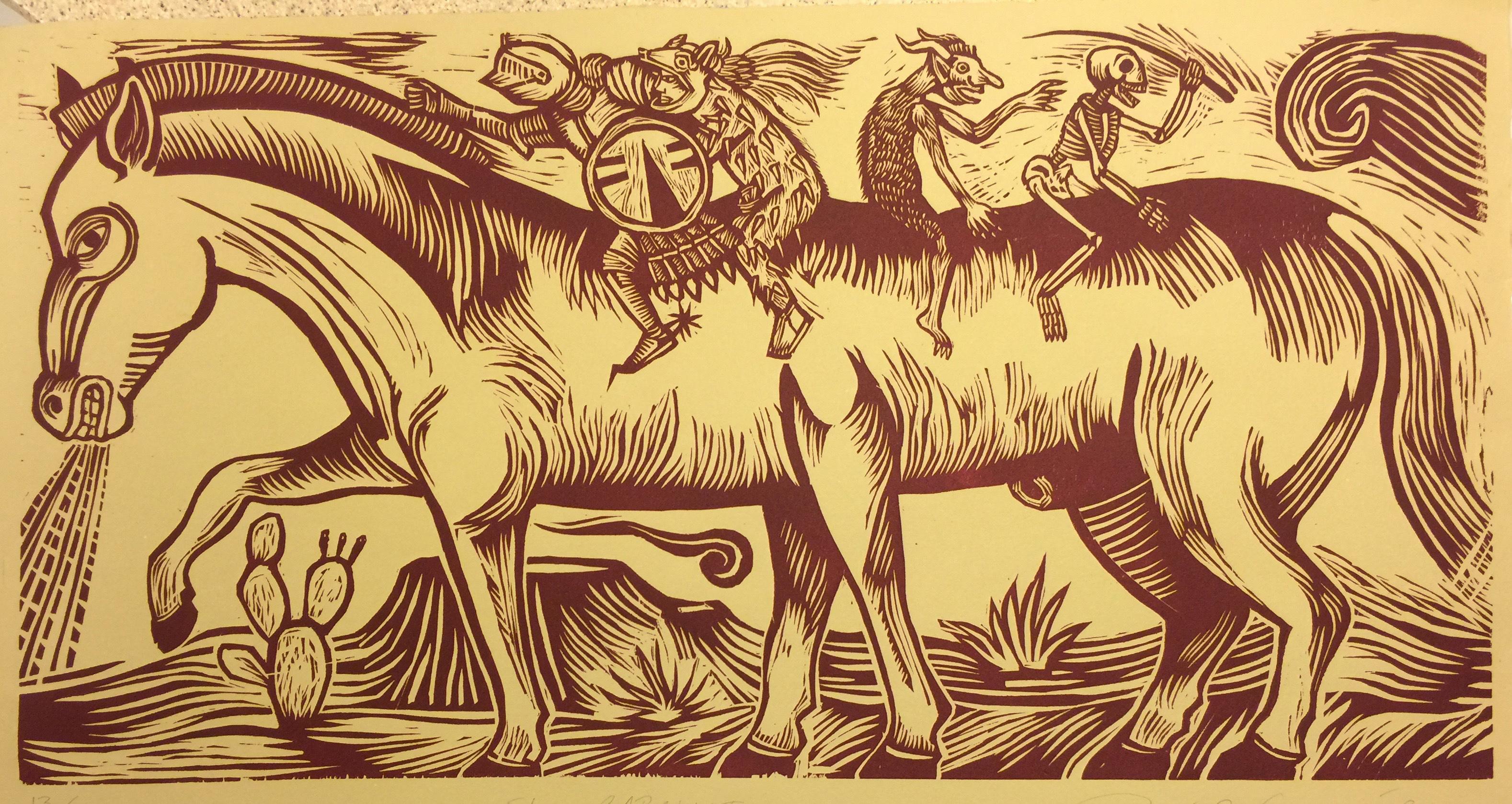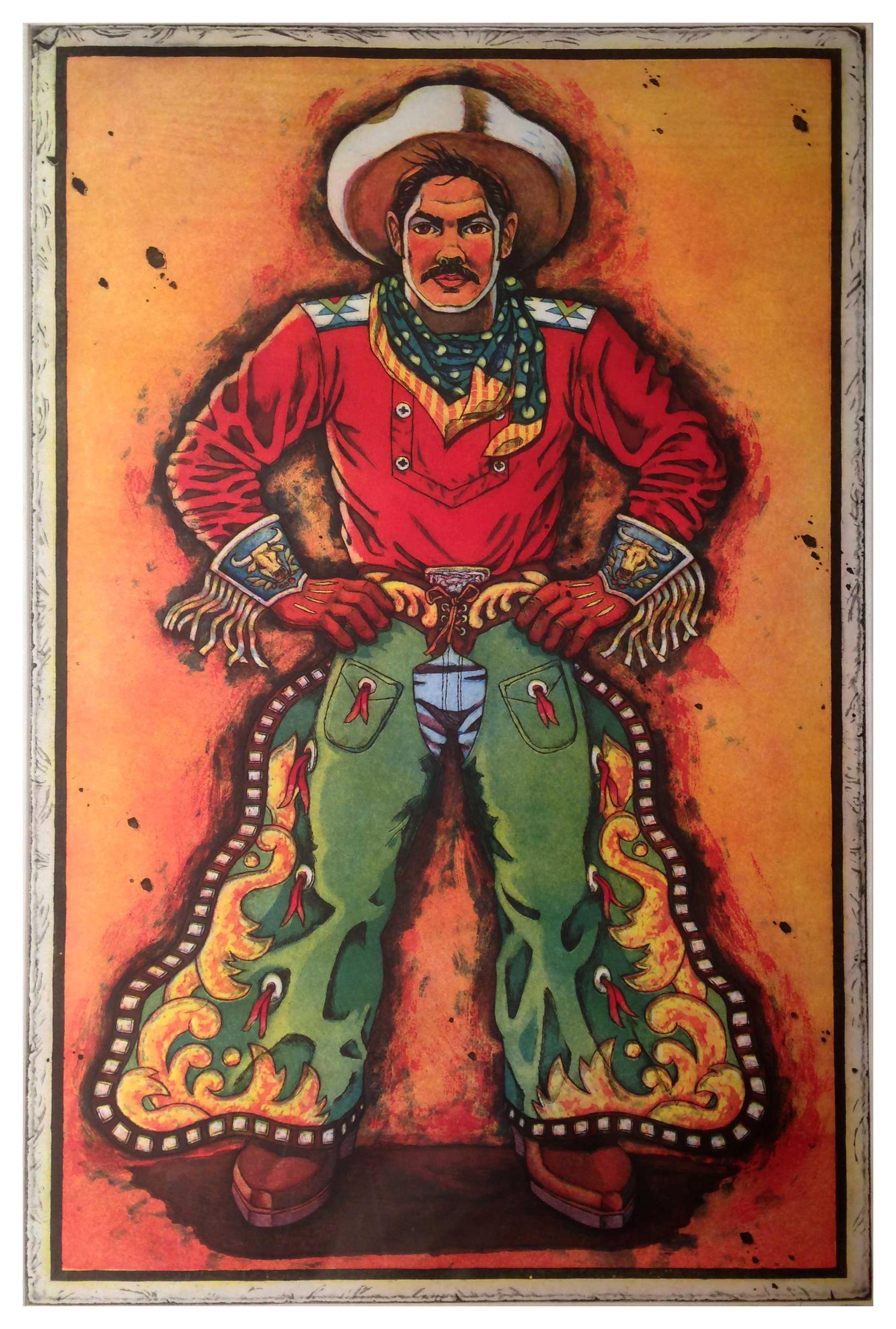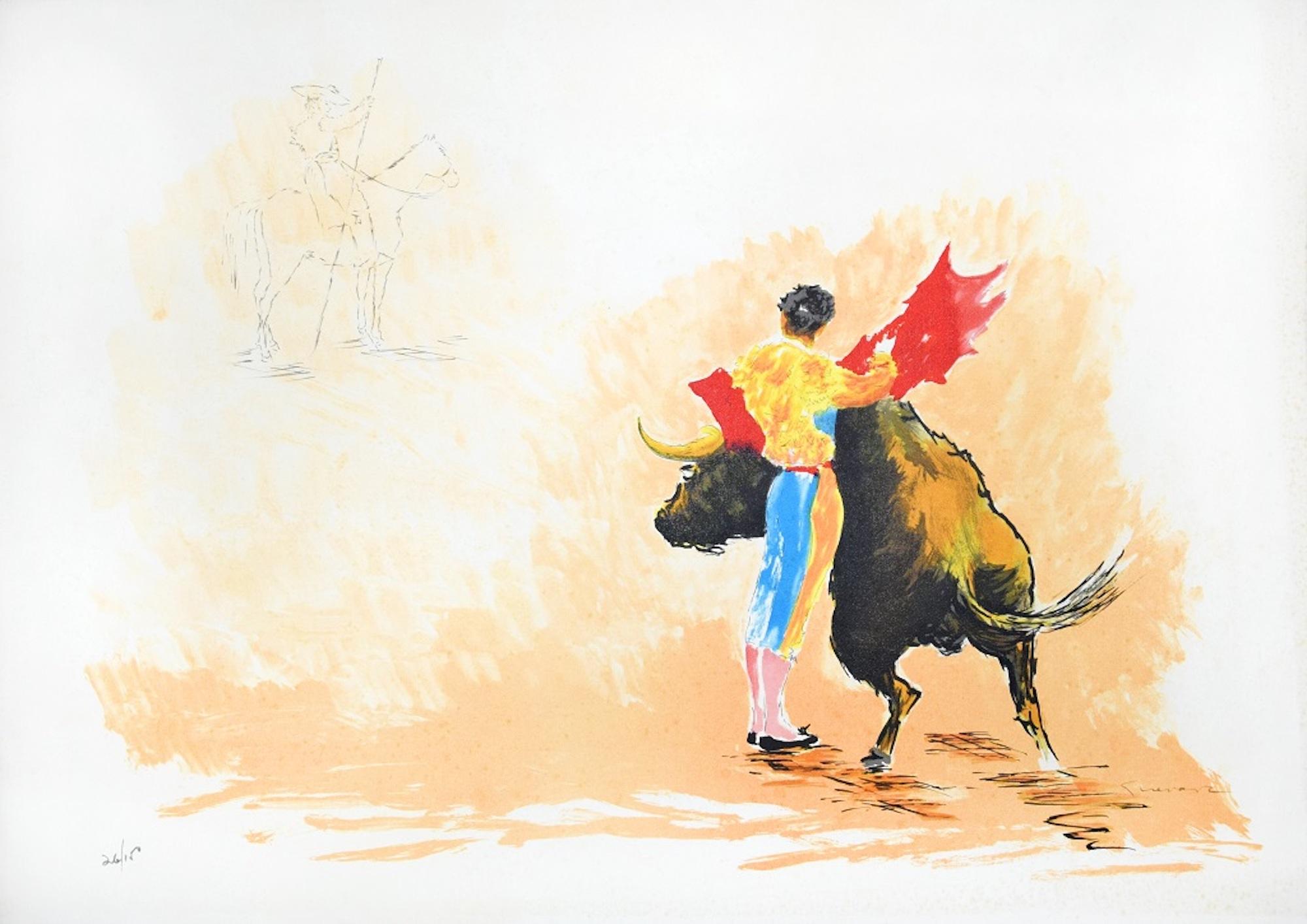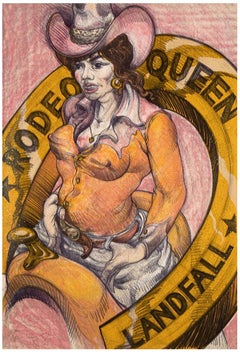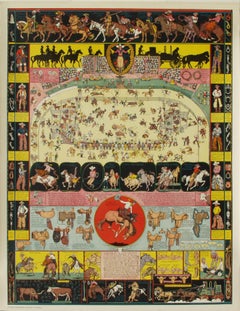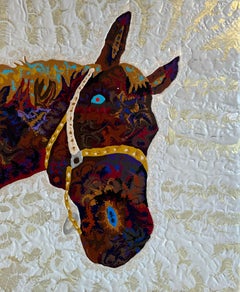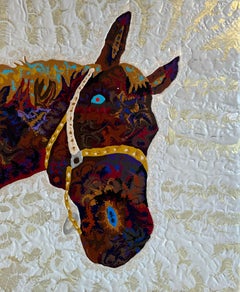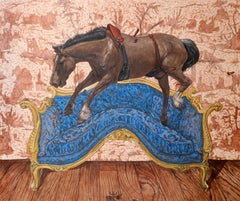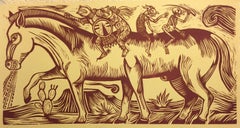Items Similar to Bronco
Want more images or videos?
Request additional images or videos from the seller
1 of 6
Luis Alfonso JimenezBronco1978
1978
$13,500
£10,541.77
€11,966.60
CA$19,420
A$21,140.71
CHF 11,144.20
MX$255,986.46
NOK 140,499.23
SEK 131,579.81
DKK 89,326.82
About the Item
SHIPPING FEES INCLUDE SHIPPING CHARGE, PACKAGING & **INSURANCE**
Luis Alfonso Jimenez
Born, 1940, El Paso, Texas, died 2006, Hondo, New Mexico.
Statement: Luis Jimenez, in his work, celebrates the vitality of life. . . . Jimenez es un hijo de la frontera; he knows its people and the landscape. It is the transformation of these people into art that is his most important contribution to the art of this vast region which stretches between Mexico and the United States.
His subject matter utilizes the popular images of the cultura del norte, and a large part of it is depicted and transformed in the rough and tumble world of la frontera. He is also a son of el norte, and so he uses its materials and explores its emerging, popular myths. The tension and attraction of Jimnez’s work is that he always creates within the space of his two worlds, the Mexicano and the Americano. He constantly shows us the irony of the two forces which repel, while showing us glimpses of the synthesis he seeks. What a gift it has been to us for this talented artist to reflect on the soul of our region. He gives meaning to our existence and history.
Rudolfo Anaya (passage chosen by the artist), A View from La Frontera, Man on Fire: Luis Jimnez, pp. 1, 3, 6Biography: Luis Jimnez was born in Texas to parents who had emigrated from Mexico to the United States; he would later dedicate his 1989 sculpture Border Crossing to his father, who had entered the country illegally. The elder Jimnez was a neon sign designer in El Paso, and Luis worked with him as a youth. His experience working in the neon shop and his fascination with U.S. car culture would both become major influences on his art career.
Jimenez studied architecture at the University of Texas, Austin (UTA), and also took art courses in which he first created sculptures with wood, steel, and fiberglass, choosing the latter because of its association with U.S. popular culture. He subsequently became one of the artists who made fiberglass an acceptable medium in the 1960s. In 1964 Jimenez received his B.S. in art from UTA, and he continued his studies at the Universidad Nacional Autnoma de Mexico in Mexico City.
In 1966 he moved to New York City and worked as an assistant to sculptor Seymour Lipton. Jimnez began to exhibit his art while in New York and in 1972 moved to New Mexico to focus on creating public sculptures, even as he maintained his diverse output of drawings, prints, and lithographs.
Drawing on his early experiences, Jimnez creates works that come from a border perspective, one that draws upon the hybridity bred by culture clashes. Often socially and politically informed, his works speak not only in regional terms, those germane to the southwestern United States, but to broader, more global issues as well. They exhibit a profoundly Chicano aesthetic and sensibility, one that is informed by Mexican and Mexican American traditions, North American popular culture, Chicano cultural icons, and images and themes unique to the Southwest. Death, sexuality, and the struggle of the common people are frequent themes.
Inspired by authors who write in an autobiographical style, Jimnez creates works that function as personal narrative yet are also able to make statements about culture in more global terms. His use of bold colors and lines, a legacy from his fathers work as a neon sign maker, lends a dynamic sensuality to his work, one that is particularly evident in his monumental fiberglass and acrylic urethane sculptural works
Many of Jimnezs works correspond to scholar Toms Ybarra-Fraustos definition of the Chicano aesthetic of rasquachismo, a lowbrow sensibility that appeals to the working class in that it applies to objects that subvert expressions of the mainstream or dominant culture. Creating art that speaks to the people, Jimnez is able to transform regional and culturally specific myths and symbols into globally recognized and relevant icons.
Exhibitions:
In addition to his personal work, Jimnez has been commissioned for numerous public art projects. In 1999 his sculpture Southwest Piet was designated a National Treasure by First Lady Hillary Clinton.
The many exhibitions featuring his work have included Human Concern/Personal Torment (Whitney Museum of American Art, New York, 1969).
The First International Motorcycle Art Show (Phoenix Art Museum, Phoenix, AZ, 1973).
Three Texas Artists (Centre Cultural Americaine, USIS, Paris, 1977),
Recent Trends in Collecting (Smithsonian Institution, Washington, DC, 1982).
Committed to Print (Museum of Modern Art, New York, 1989)
Printmaking in Texas: The 1980s (Modern Art Museum, Fort Worth, TX.
Laguna Gloria Art Museum, Austin, 1990.
The Whitney Biennial (Whitney Museum of American Art, New York, 1991)
Man On Fire: Luis Jimnez (Albuquerque Museum of Art, NM, 1994-95).
47th Annual Purchase Exhibition (American Academy of Arts and Letters, New York, 1995).
Traveling solo exhibition, Working Class Heroes: Images from the Popular Culture (1997-2000).
Jiménez
Collier Gallery has been in continuous operation for over 40 years. Originally located just off Main Street in downtown Scottsdale, Arizona, we have moved to Phoenix to accommodate and showcase our large inventory including:
• Original works by Maynard Dixon, Lon Megargee, Ed Mell, Fritz Scholder, Bill Schenck, Bill Lesch, Luis Jimenez, Greg
Singley, Dan Budnik, and other 20th century Western, WPA and Contemporary Southwestern artists.
• The Fine Art Estate of Lon Megargee
• Vintage rodeo photography from our collection, hand colored, & reproduced in very large format, archival quality.
• Western Antiques and Mid Century Modern furnishing, lighting, lamps and chandeliers from the 40s, 50s and 60s
Michael Collier has over 45 years of fine art expertise and framing design. A custom frame maker offering hand carved, gilded frames, finished in wood tones and genuine gold leaf. Michael has designed original signature frames for artists, museums and premier dealers across the United States. Michael is one of a few people in Arizona who has mastered the skill of hand dying mats and French Matting.
We provide custom picture framing services to designers, museums, galleries, artists, and private collectors. Custom picture and art framing, including original hand carved, gilded frames, mirror frames and special custom leather frames. All picture framing is done to archival standards with a specialty in hand dyed mats and french matting. Custom mirror frames in traditional, contemporary or western styles, designed to fit your home or business. Signature frames for Lon Megargee, Maynard Dixon, Ed Mell and Greg Singley.
All images copyright © 2000-2023 by Michael Collier. Permission to reproduce photos and paintings on this website and online catalog secured by Michael Collier. All rights reserved. No portion of this website and online catalog may be reproduced in any manner whatsoever without written permission from Michael Collier, Collier Gallery.
Disclaimer: Pricing and availability are subject to change without notice; please confirm the description of artwork or item when you contact us.
- Creator:Luis Alfonso Jimenez (1940 - 2006, American)
- Creation Year:1978
- Dimensions:Height: 28 in (71.12 cm)Width: 39.75 in (100.97 cm)
- Medium:
- Movement & Style:
- Period:
- Condition:
- Gallery Location:Phoenix, AZ
- Reference Number:1stDibs: LU2623212843022
About the Seller
No Reviews Yet
Vetted Professional Seller
Every seller passes strict standards for authenticity and reliability
1stDibs seller since 2023
8 sales on 1stDibs
- ShippingRetrieving quote...Shipping from: Phoenix, AZ
- Return Policy
Authenticity Guarantee
In the unlikely event there’s an issue with an item’s authenticity, contact us within 1 year for a full refund. DetailsMoney-Back Guarantee
If your item is not as described, is damaged in transit, or does not arrive, contact us within 7 days for a full refund. Details24-Hour Cancellation
You have a 24-hour grace period in which to reconsider your purchase, with no questions asked.Vetted Professional Sellers
Our world-class sellers must adhere to strict standards for service and quality, maintaining the integrity of our listings.Price-Match Guarantee
If you find that a seller listed the same item for a lower price elsewhere, we’ll match it.Trusted Global Delivery
Our best-in-class carrier network provides specialized shipping options worldwide, including custom delivery.More From This Seller
View AllTexas Swing by Luis Jimenez
By Luis Jiménez
Located in Phoenix, AZ
Texas Swing
Luis Alfonso Jimenez 1940-2006
Stone Lithograph Edition of 50
Artist Proof
24 x 18 inches
Luis Alfonso Jimenez
Born, 1940, El Paso, Texas, died 2006, Hondo, New Mexico.
Statement: Luis Jimenez, in his work, celebrates the vitality of life. . . . Jimenez es un hijo de la frontera; he knows its people and the landscape. It is the transformation of these people into art that is his most important contribution to the art of this vast region which stretches between Mexico and the United States.
His subject matter utilizes the popular images of the cultura del norte, and a large part of it is depicted and transformed in the rough and tumble world of la frontera. He is also a son of el norte, and so he uses its materials and explores its emerging, popular myths. The tension and attraction of Jimnez’s work is that he always creates within the space of his two worlds, the Mexicano and the Americano. He constantly shows us the irony of the two forces which repel, while showing us glimpses of the synthesis he seeks. What a gift it has been to us for this talented artist to reflect on the soul of our region. He gives meaning to our existence and history.
Rudolfo Anaya (passage chosen by the artist), A View from La Frontera, Man on Fire: Luis Jimnez, pp. 1, 3, 6Biography: Luis Jimnez was born in Texas to parents who had emigrated from Mexico to the United States; he would later dedicate his 1989 sculpture Border Crossing to his father, who had entered the country illegally. The elder Jimenez was a neon sign designer in El Paso, and Luis worked with him as a youth. His experience working in the neon shop and his fascination with U.S. car culture would both become major influences on his art career.
Jimenez studied architecture at the University of Texas, Austin (UTA), and also took art courses in which he first created sculptures with wood, steel, and fiberglass, choosing the latter because of its association with U.S. popular culture. He subsequently became one of the artists who made fiberglass an acceptable medium in the 1960s. In 1964 Jimenez received his B.S. in art from UTA, and he continued his studies at the Universidad Nacional Autonoma de Mexico in Mexico City.
In 1966 he moved to New York City and worked as an assistant to sculptor Seymour Lipton. Jimnez began to exhibit his art while in New York and in 1972 moved to New Mexico to focus on creating public sculptures, even as he maintained his diverse output of drawings, prints, and lithographs.
Drawing on his early experiences, Jimenez creates works that come from a border perspective, one that draws upon the hybridity bred by culture clashes. Often socially and politically informed, his works speak not only in regional terms, those germane to the southwestern United States, but to broader, more global issues as well. They exhibit a profoundly Chicano aesthetic and sensibility, one that is informed by Mexican and Mexican American traditions, North American popular culture, Chicano cultural icons, and images and themes unique to the Southwest. Death, sexuality, and the struggle of the common people are frequent themes.
Inspired by authors who write in an autobiographical style, Jimenez creates works that function as personal narrative yet are also able to make statements about culture in more global terms. His use of bold colors and lines, a legacy from his fathers work as a neon sign maker, lends a dynamic sensuality to his work, one that is particularly evident in his monumental fiberglass and acrylic urethane sculptural works
Many of Jimenez's works correspond to scholar Toms Ybarra-Fraustos definition of the Chicano aesthetic of rasquachismo, a lowbrow sensibility that appeals to the working class in that it applies to objects that subvert expressions of the mainstream or dominant culture. Creating art that speaks to the people, Jimenez is able to transform regional and culturally specific myths and symbols into globally recognized and relevant icons.
Exhibitions:
In addition to his personal work, Jimenez has been commissioned for numerous public art projects. In 1999 his sculpture Southwest Piet was designated a National Treasure by First Lady Hillary Clinton.
The many exhibitions featuring his work have included Human Concern/Personal Torment (Whitney Museum of American Art, New York, 1969).
The First International Motorcycle Art Show (Phoenix Art Museum, Phoenix, AZ, 1973).
Three Texas Artists (Centre Cultural Americaine, USIS, Paris, 1977),
Recent Trends in Collecting (Smithsonian Institution, Washington, DC, 1982).
Committed to Print (Museum of Modern Art, New York, 1989)
Printmaking in Texas: The 1980s (Modern Art Museum, Fort Worth, TX.
Laguna Gloria Art Museum, Austin, 1990.
The Whitney Biennial (Whitney Museum of American Art, New York, 1991)
Man On Fire: Luis Jimnez (Albuquerque Museum of Art, NM, 1994-95).
47th Annual Purchase Exhibition (American Academy of Arts and Letters, New York, 1995).
Traveling solo exhibition, Working Class Heroes: Images from the Popular Culture (1997-2000).
Jiménez
Collier Gallery has been in continuous operation for over 40 years. Originally located just off Main Street in downtown Scottsdale, Arizona, we have moved to Phoenix to accommodate and showcase our large inventory including:
• Original works by Maynard Dixon, Lon Megargee, Ed Mell, Fritz Scholder, Bill Schenck, Bill Lesch, Luis Jimenez, Greg
Singley, Dan Budnik, and other 20th century Western, WPA and Contemporary Southwestern artists.
• The Fine Art Estate of Lon Megargee
• Vintage rodeo...
Category
1970s Contemporary Figurative Prints
Materials
Lithograph
Rodeo Queen by Luis Jimenez
Located in Phoenix, AZ
Rodeo Queen, 1981
Edition 36/50
Signed lower left, Inscribed: for the "Rose" 82.
Provenance: Print was a gift to Rozanne Charington, companion and model for "Rodeo Queen", "Rose Tattoo" and "Jimenez at Adeliza's Candy Store".
Lithograph on paper
42 ½ × 29 in. (107.3 × 73.7 cm)
Luis Alfonso Jimenez
Born, 1940, El Paso, Texas, died 2006, Hondo, New Mexico.
Statement: Luis Jimenez, in his work, celebrates the vitality of life. . . . Jimenez es un hijo de la frontera; he knows its people and the landscape. It is the transformation of these people into art that is his most important contribution to the art of this vast region which stretches between Mexico and the United States.
His subject matter utilizes the popular images of the cultura del norte, and a large part of it is depicted and transformed in the rough and tumble world of la frontera. He is also a son of el norte, and so he uses its materials and explores its emerging, popular myths. The tension and attraction of Jimnez’s work is that he always creates within the space of his two worlds, the Mexicano and the Americano. He constantly shows us the irony of the two forces which repel, while showing us glimpses of the synthesis he seeks. What a gift it has been to us for this talented artist to reflect on the soul of our region. He gives meaning to our existence and history.
Rudolfo Anaya (passage chosen by the artist), A View from La Frontera, Man on Fire: Luis Jimenez, pp. 1, 3, 6Biography: Luis Jimenez was born in Texas to parents who had emigrated from Mexico to the United States; he would later dedicate his 1989 sculpture Border Crossing to his father, who had entered the country illegally. The elder Jimenez was a neon sign designer in El Paso, and Luis worked with him as a youth. His experience working in the neon shop and his fascination with U.S. car culture would both become major influences on his art career.
Jimenez studied architecture at the University of Texas, Austin (UTA), and also took art courses in which he first created sculptures with wood, steel, and fiberglass, choosing the latter because of its association with U.S. popular culture. He subsequently became one of the artists who made fiberglass an acceptable medium in the 1960s. In 1964 Jimenez received his B.S. in art from UTA, and he continued his studies at the Universidad Nacional Autonoma de Mexico in Mexico City.
In 1966 he moved to New York City and worked as an assistant to sculptor Seymour Lipton. Jimenez began to exhibit his art while in New York and in 1972 moved to New Mexico to focus on creating public sculptures, even as he maintained his diverse output of drawings, prints, and lithographs.
Drawing on his early experiences, Jimenez creates works that come from a border perspective, one that draws upon the hybridity bred by culture clashes. Often socially and politically informed, his works speak not only in regional terms, those germane to the southwestern United States, but to broader, more global issues as well. They exhibit a profoundly Chicano aesthetic and sensibility, one that is informed by Mexican and Mexican American traditions, North American popular culture, Chicano cultural icons, and images and themes unique to the Southwest. Death, sexuality, and the struggle of the common people are frequent themes.
Inspired by authors who write in an autobiographical style, Jimenez creates works that function as personal narrative yet are also able to make statements about culture in more global terms. His use of bold colors and lines, a legacy from his fathers work as a neon sign maker, lends a dynamic sensuality to his work, one that is particularly evident in his monumental fiberglass and acrylic urethane sculptural works
Many of Jimenez's works correspond to scholar Toms Ybarra-Fraustos definition of the Chicano aesthetic of rasquachismo, a lowbrow sensibility that appeals to the working class in that it applies to objects that subvert expressions of the mainstream or dominant culture. Creating art that speaks to the people, Jimenez is able to transform regional and culturally specific myths and symbols into globally recognized and relevant icons.
Exhibitions:
In addition to his personal work, Jimenez has been commissioned for numerous public art projects. In 1999 his sculpture Southwest Piet was designated a National Treasure by First Lady Hillary Clinton.
The many exhibitions featuring his work have included Human Concern/Personal Torment (Whitney Museum of American Art, New York, 1969).
The First International Motorcycle Art Show (Phoenix Art Museum, Phoenix, AZ, 1973).
Three Texas Artists (Centre Cultural Americaine, USIS, Paris, 1977),
Recent Trends in Collecting (Smithsonian Institution, Washington, DC, 1982).
Committed to Print (Museum of Modern Art, New York, 1989)
Printmaking in Texas: The 1980s (Modern Art Museum, Fort Worth, TX.
Laguna Gloria Art Museum, Austin, 1990.
The Whitney Biennial (Whitney Museum of American Art, New York, 1991)
Man On Fire: Luis Jimnez (Albuquerque Museum of Art, NM, 1994-95).
47th Annual Purchase Exhibition (American Academy of Arts and Letters, New York, 1995).
Traveling solo exhibition, Working Class Heroes: Images from the Popular Culture (1997-2000).
Jiménez
Collier Gallery has been in continuous operation for over 40 years. Originally located just off Main Street in downtown Scottsdale, Arizona, we have moved to Phoenix to accommodate and showcase our large inventory including:
• Original works by Maynard Dixon, Lon Megargee, Ed Mell, Fritz Scholder, Bill Schenck, Bill Lesch, Luis Jimenez, Greg
Singley, Dan Budnik, and other 20th century Western, WPA and Contemporary Southwestern artists.
• The Fine Art Estate of Lon Megargee
• Vintage rodeo...
Category
1980s Contemporary Figurative Prints
Materials
Lithograph
Misfit by Greg Singley
Located in Phoenix, AZ
Title: Misfit
Artist: Greg Singley
Signed original signature
Archival Pigment Print,
100% Rag Paper 300 gm
Paper size: 24 x34 inches
Image Size: 20 x 30 inches
Greg Singley
Greg Singley – was born in 1950 in Greensboro, Alabama. He received his Associates Degree at Walker Collage Jasper Alabama and furthered his college education at the University of South Alabama, Mobile Alabama. He attended the revered Ringling School of Art for his art training in Sarasota Florida and graduated with honors with a certificate in commercial illustration.
In 1978 Singley moved to Phoenix Arizona to pursue his passion for western art and illustration. He worked for several years as an art director for Phoenix Public News and as a freelance illustrator and at the same time experienced sales of Native American and Western Landscape in several Arizona galleries which include Ratliff Williams Gallery, Sedona Arizona, Fagan Peterson Fine Art, Scottsdale and the Dan May Gallery, Scottsdale Arizona.
After a foray into freelance illustration Singley sought representation for his varied abilities and interest in fine art and found the Phoenix Art Group...
Category
2010s Contemporary Figurative Prints
Materials
Archival Pigment
Jo Mora, Evolution of the Cowboy 1933, from Jo Mora Estate
Located in Phoenix, AZ
"LAST ONE IN MINT CONDITION"
Evolution of the Cowboy, 1933
Original Lithograph
Excellent condition, came directly from Jo Mora Jr.
Unframed!!
SHIPPING CHARGES INCLUDE SHIPPING, PACKAGING & INSURANCE
Original version was called Evolution of the Cowboy, 1933 or referred today as "Sweetheart of the Rodeo", Images from the poster were used for "Sweetheart of the Rodeo", the sixth album by American rock band the Byrds and was released on August 30, 1968. It was hated when released, today it is considered one of the great classics.
This is an original lithograph from the Jo Mora Estate from Jo Mora Jr.
Joseph Jacinto Mora (October 22, 1876 – October 10, 1947) was a Uruguayan-born American cowboy, photographer, artist, cartoonist, illustrator, painter, muralist, sculptor, and historian who wrote about his experiences in California. He has been called the "Renaissance Man of the West".
Early life
Mora was born on October 22, 1876, in Montevideo, Uruguay. His father was the Catalan sculptor, Domingo Mora, and his mother was Laura Gaillard Mora, an intellectual born in the Bordeaux region of France. His elder brother was F. Luis Mora, who would become an artist and the first Hispanic member of the National Academy of Design. The family entered the United States in 1880 and first settled in New York City, and then Perth Amboy, New Jersey.
Jo Mora 1931 Yosemite map
Jo Mora studied art at the Art Students League of New York and the Cowles Art School in Boston. He also studied with William Merritt Chase. He worked as a cartoonist for the Boston Evening Traveller, and later, the Boston Herald.
In the spring of 1903, Mora arrived in Solvang, California. He stayed at the Donohue Ranch. He made plans to travel to the Southwest to paint and photograph the Hopi. He spent time at the Mission Santa Inés; those photographs are now maintained by the Smithsonian Institution. Mora visited many Spanish missions in California that summer by horseback. He followed the "Mission Trail", also called the "Kings Highway".
In 1904, Mora visited Yosemite. Later, in 1904, to 1906, visited Arizona where he took photographs, painted and otherwise recorded the daily life of these Native Americans. Because the Hopi and other tribes have voiced their concerns more recently about photographs depicting religious ceremonies, the tribal nation should be contacted before they are used. He learned the Native languages and made detailed drawings of what he observed.
Career
In 1907, Mora wrote and illustrated the comic strip Animaldom.
In 1907, Mora returned to California and married Grace Needham. Their son, Joseph Needham Mora, was born on March 8, 1908. The Moras moved to San Jose, California, where Mora continued his work.
On 22 February 1911, the Native Sons of the Golden West Building, in San Francisco, with six terra cotta panels, by Domingo Mora and his son, Jo Mora, was dedicated.
In 1915, he served on the International Jury of Awards at the Panama–Pacific International Exposition and displayed six sculptures.[9]
In 1915-16 two of his sculptural commissions were revealed: the bronze memorial tablet with the profile of the late Archbishop Patrick W. Riordan for the Knights of Columbus and the Cervantes Monument in San Francisco's Golden Gate Park.[10][11] By 1919, he was sculpting for the Bohemian Club, including the Bret Harte Memorial plaque, completed in August 1919 and mounted on the outside of the private men's club building in San Francisco.
Carmel-by-the-Sea
In 1921, the Mora family relocated to Carmel-by-the-Sea, California, the largest art colony on the West Coast, making it their primary residence. He constructed a Craftsman-style home, which is located on the west side of San Carlos Street, the third house south of 1st Avenue.
Mora received a commission for the bronze and travertine Cenotaph, for Father Junípero Serra in the Memorial Chapel at the west end of Mission Carmel.
Mora was a director of the Carmel Art Association as early as 1934. His sculptures were exhibited between 1927 and 1934 in various galleries in Carmel.
Jo Mora is a serious sculptor, a responsible amateur actor; when mixed up with pen and ink, a humorist! Comic strips was once his trade. He was famous at it. That was years ago but his art of cartooning bloomed again when in recent years he produced the well known Mora Map of the Monterey Peninsula. Most successful with bronze statue creations which decorate many gardens in East and West. If he has a specialty in figures it is cowboys. He knows his West. Jo Mora will ever be famed for his portrayal of Pancho Lopez, The Bad Man, at Carmel Playhouse. He does everything well and is handsome while doing it. He is happily married-alas!
— Carmel Pine Cone
During the Great Depression, Mora created the "Carmel Dollar" as part of Carmel's program, offering unemployed residents scrip for public service, exchangeable for groceries and essentials; a three-cent stamp on the certificate's back acknowledged their efforts. When full, merchants accepted the certified scrip for goods or a dollar.
Architect Robert Stanton...
Category
1930s Other Art Style More Prints
Materials
Lithograph
Wide Open by Greg Singley
Located in Phoenix, AZ
Title: Wide Open
Artist: Greg Singley
Archival Pigment Print
100% Cotton Rag 300gm
Image size: 20 x 32.625
Paper size: 24 x 36 inches
Greg Singley
Greg Singley – was born in 1950 in Greensboro, Alabama. He received his Associates Degree at Walker Collage Jasper Alabama and furthered his college education at the University of South Alabama, Mobile Alabama. He attended the revered Ringling School of Art for his art training in Sarasota Florida and graduated with honors with a certificate in commercial illustration.
In 1978 Singley moved to Phoenix Arizona to pursue his passion for western art and illustration. He worked for several years as an art director for Phoenix Public News and as a freelance illustrator and at the same time experienced sales of Native American and Western Landscape in several Arizona galleries which include Ratliff Williams Gallery, Sedona Arizona, Fagan Peterson Fine Art, Scottsdale and the Dan May Gallery, Scottsdale Arizona.
After a foray into freelance illustration Singley sought representation for his varied abilities and interest in fine art and found the Phoenix Art Group...
Category
2010s Contemporary Figurative Prints
Materials
Archival Pigment
The Bronc by Lon Megargee
Located in Phoenix, AZ
Lon Megargee 1883-1960
"The Bronc"
Wood block print
Signed in plate, lower right
Image size: 9 x 10 inches
Frame size 21 x 21.5 inches
Creator of Stetson's hat logo "Last Drop from his Hat"
Lon Megargee
1883 - 1960
At age 13, Lon Megargee came to Phoenix in 1896 following the death of his father in Philadelphia. For several years he resided with relatives while working at an uncle’s dairy farm and at odd jobs. He returned to Philadelphia in 1898 – 1899 in order to attend drawing classes at the Pennsylvania Academy of the Fine Arts. Back in Phoenix in 1899, he decided at the age of 16 to try to make his living as a cowboy.
Lon moved to the cow country of Wickenburg, Arizona where he was hired by Tex Singleton’s Bull Ranch. He later joined the Three Bar R. . . and after a few years, was offered a job by Billy Cook of the T.T. Ranch near New River. By 1906, Megargee had learned his trade well enough to be made foreman of Cook’s outfit.
Never shy about taking risks, Lon soon left Cook to try his own hand at ranching. He partnered with a cowpuncher buddy, Tom Cavness, to start the El Rancho Cinco Uno at New River. Unfortunately, the young partners could not foresee a three-year drought that would parch Arizona, costing them their stock and then their hard-earned ranch.
Breaking with his romantic vision of cowboy life, Megargee finally turned to art full time. He again enrolled at the Pennsylvania Academy of Art and then the Los Angeles School of Art and Design during 1909 – 1910. The now well-trained student took his first trip to paint “en plein air” (outdoors) to the land of Hopi and Navajo peoples in northern Arizona. After entering paintings from this trip in the annual Territorial Fair at Phoenix, in 1911, he surprisingly sold his first oil painting to a major enterprise – the Santa Fe Railroad . . . Lon received $50 for “Navajos Watching the Santa Fe Train.” He soon sold the SFRR ten paintings over the next two years. For forty years the railroad was his most important client, purchasing its last painting from him in 1953.
In a major stroke of good fortune during his early plein-air period, Megargee had the opportunity to paint with premier artist, William R. Leigh (1866 – 1955). Leigh furnished needed tutoring and counseling, and his bright, impressionistic palette served to enhance the junior artist’s sense of color and paint application. In a remarkable display of unabashed confidence and personable salesmanship, Lon Megargee, at age 30, forever linked his name with Arizona art history. Despite the possibility of competition from better known and more senior artists, he persuaded Governor George Hunt and the Legislature in 1913 to approve 15 large, historic and iconic murals for the State Capitol Building in Phoenix. After completing the murals in 1914, he was paid the then princely sum of roughly $4000. His Arizona statehood commission would launch Lon to considerable prominence at a very early point in his art career.
Following a few years of art schooling in Los Angeles, and several stints as an art director with movie studios, including Paramount, Megargee turned in part to cover illustrations for popular Western story magazines in the 1920s.
In the 1920s, as well, Lon began making black and white prints of Western types and of genre scenes from woodblocks. These prints he generally signed and sold singly. In 1933, he published a limited edition, signed and hard-cover book (about 250 copies and today rare)containing a group of 28 woodblock images. Titled “The Cowboy Builds a Loop,” the prints are noteworthy for strong design, excellent draftsmanship, humanistic and narrative content, and quality. Subjects include Southwest Indians and cowboys, Hispanic men and women, cattle, horses, burros, pioneers, trappers, sheepherders, horse traders, squaw men and ranch polo players. Megargee had a very advanced design sense for simplicity and boldness which he demonstrated in how he used line and form. His strengths included outstanding gestural (action) art and strong figurative work. He was superb in design, originality and drawing, as a study of his prints in the Hays collection reveals.
In 1944, he published a second group of Western prints under the same title as the first. Reduced to 16 images from the original 28 subjects, and slightly smaller, Lon produced these prints in brown ink on a heavy, cream-colored stock. He designed a sturdy cardboard folio to hold each set. For the remainder of his life, Lon had success selling these portfolios to museum stores, art fairs and shows, and to the few galleries then selling Western art.
Drawing on real working and life experiences, Lon Megargee had a comprehensive knowledge, understanding and sensitivity for Southwestern subject matter. Noted American modernist, Lew Davis...
Category
Early 20th Century American Impressionist Figurative Prints
Materials
Woodcut
You May Also Like
Bronco
Located in Bozeman, MT
In 1993, a window of opportunity opened as a result of several different situations that were occurring. I was participating in an Artist-in-Residence program in Yellowstone Nationa...
Category
2010s Animal Paintings
Materials
Acrylic
$4,500
Bronco
Located in Bozeman, MT
With a striking palette and sharp, swirling holographic textures, Bronco offers a modern reimagining of a classic montana bronco. The stylized rendering and explosive background patt...
Category
21st Century and Contemporary Animal Paintings
Materials
Acrylic
$4,500
American Contemporary Art by Carlos Gamez de Francisco - Equestrian Style
Located in Paris, IDF
Oil on canvas
Carlos Gamez de Francisco is an American artitst with Cuban origins born in 1987 who lives and works in Fort Myers, FL, and Louisville, KY. He has received numerous aw...
Category
2010s Contemporary Figurative Paintings
Materials
Oil, Canvas
El Caballito
By Daniel Gonzalez
Located in Palm Springs, CA
Contemporary Mexican linocut print. El Caballito normally refers to a rocking horse or hobby horse, but this one is large enough to carry knights in armor, devils and the figure of death on his back. From the edition of 15.
Daniel Gonzalez was raised in Los Angeles and received his training at the California College of Arts and Crafts. He also apprenticed with Artemio Rodriguez...
Category
2010s Contemporary Portrait Prints
Materials
Linocut
El Vaquero, by Xavier Viramontes
By Xavier Viramontes
Located in Palm Springs, CA
This is one of six cowboy images completed by the artist. Chicano artist Viramontes is known for both political subject matter, as well as more personal s...
Category
21st Century and Contemporary Contemporary Figurative Prints
Materials
Etching, Aquatint
$720 Sale Price
20% Off
Corrida - Original Lithograph by José Guevara - 1990s
Located in Roma, IT
Corrida is a beautiful artwork realized by Josè Guevara in the 1990s.
Colored lithograph on paper. Edited by Fondazione Di Paolo.
The lithograph is hand...
Category
1990s Contemporary Figurative Prints
Materials
Lithograph



